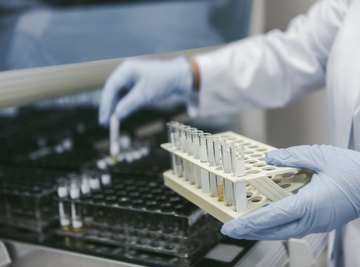
The science world is filled with different ways to express the vital concept of concentration, which is the amount of something present per unit volume. This "amount" often has units of mass but can include virtually anything that can be quantified: gas particles, photons and more.
The volume in question is often a solution, which involves a substance (called a solute in this context) dissolved in a liquid (called a solvent).
When solid dissolves in a solvent to create a solution, the concentration of the solution can be expressed in a variety of ways. This relates to the fact that chemicals react with each other not on the basis of mass but on the basis of the ratio of individual "pieces," regardless of size.
The concept of moles and equivalents, and thus millimoles and milliequivalents, underlies this relationship, and it is of vital importance in medicine and clinical pharmacology.
Moles and Molecular Weight
In an example of a simple chemical reaction, one atom of potassium (K) can react with one atom of chlorine (Cl) to form a molecule of potassium chloride (KCl) with nothing left over. But this is not because potassium atoms and chlorine atoms have the same mass. Instead, it is because K and Cl react in a 1-to-1 molar ratio.
A mole consists of 6.02 × 1023 irreducible "pieces" (atoms or molecules) of a substance. Every element's molar mass, or the mass of a single mole in grams is given in the periodic table of elements (see the Resources for an online version). For example, carbon has 12.11 g. This means that one mole (1 mol) of C atoms has a mass of 12.011 g.
Because atoms become more massive as you move from lower to higher atomic numbers in the periodic table, molar masses vary enormously, with that of uranium being over 200 times that of hydrogen.
Moles and Equivalents
The equivalent unit was introduced to account for the fact that when solutes dissolve in solvent to create a solution, the number of particles dispersed depends on the valence of the solute. For example, when one molecule of KCl dissolves, it leaves two ions, or charged particles − a K+ ion and a Cl- ion. This means that KCl has a valence of 2.
Similarly, CaCl2 separates into three ions per molecule of solute (1 Ca+ and 2 Cl-) and thus has a valence of 3. This leads to the definition of an equivalent, or specifically a milliequivalent:
This equation assumes that both mass and MW, or molecular weight (the same as molar mass but applied to molecules instead of single atoms), are given in milligrams.
Equivalents per liter is therefore a unit of concentration, but the most commonly seen unit throughout chemistry is the mEq/L.
Examples of mEq/L
1. How many mEq of potassium are there in 750 mL of solution that has a K+ concentration of 58.65 mg/L? (Note: The molar mass of potassium, given in the periodic table, is 39.1 g/mol.)
- First, you need the total mass of potassium in this solution, which is obtained by multiplying the concentration in mg/L by the volume of solution in liters:
(78.2 mg/L)(0.75 L) = 58.65 mg
From the above equation, and with the valence of elemental potassium being 1, you have mEq = [(58.65 mg)(1)]/39.1 mg/mmol = 1.5 mEq.
A solution contains 30 mg of NaCl (table salt) per 400 mL of solution. Express the solution in terms of milliequivalents per liter (mEq/L). (Note: the molecular weight of NaCl is 58.44 g/mol.)
- This time, the solute has a valence of 2, as NaCl separates into Na+ and Cl-. The equation to get mEq is therefore [(30 mg)(2)]/(58.44 mg/mmol) = 1.027 mEq.
Since there are 400 mL = 0.4 L, the concentration in mEq/L is therefore 1.027/0.4 = 2.567 mEq/L.
References
Resources
About the Author
Kevin Beck holds a bachelor's degree in physics with minors in math and chemistry from the University of Vermont. Formerly with ScienceBlogs.com and the editor of "Run Strong," he has written for Runner's World, Men's Fitness, Competitor, and a variety of other publications. More about Kevin and links to his professional work can be found at www.kemibe.com.
